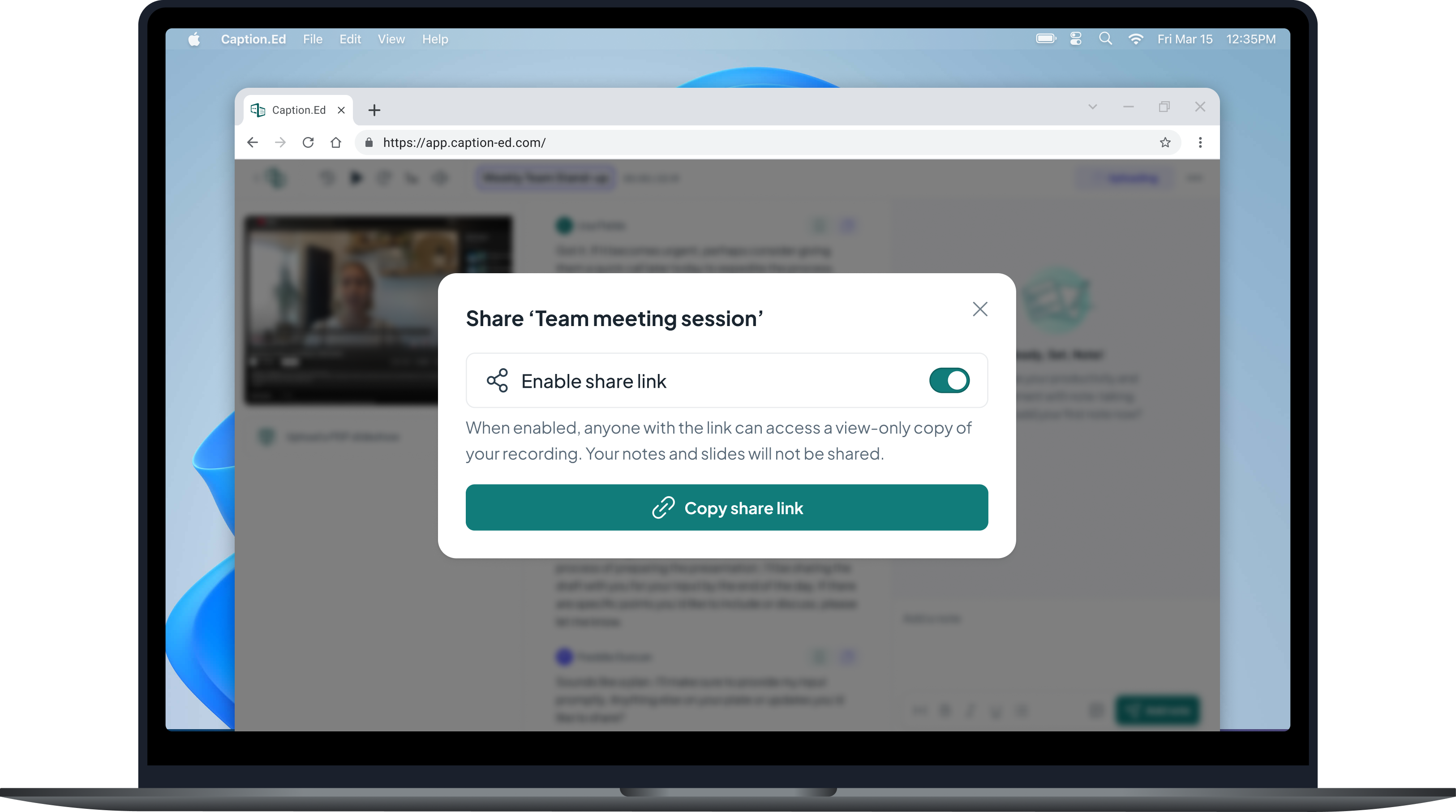The Best Transcription Software in 2025
[8+ Tools Reviewed]
Looking for accurate, accessible, and easy-to-use transcription software? Here’s our breakdown of the top tools for 2025.
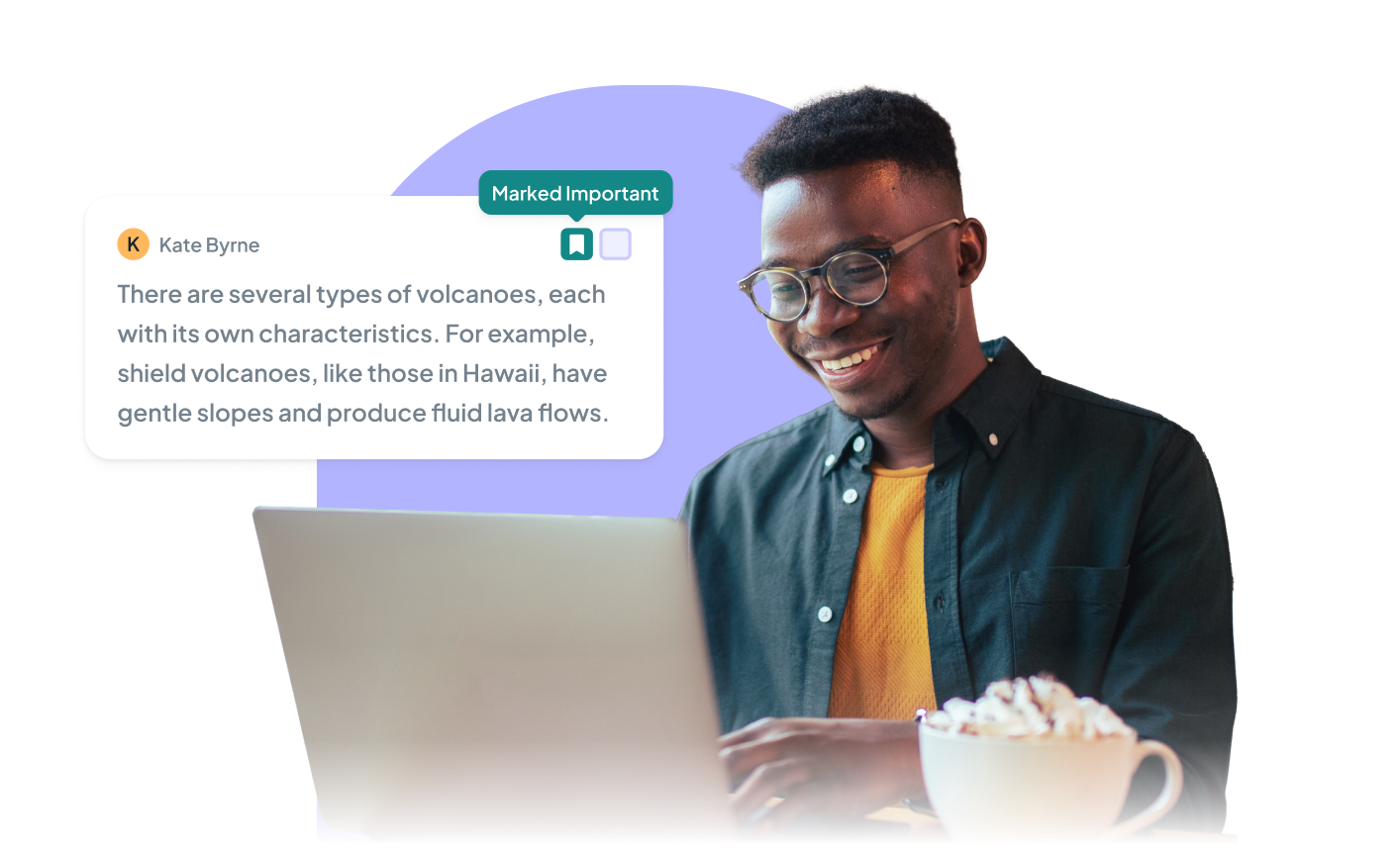

Which transcription tools stand out in 2025?
- Best for Overall Experience: Caption.Ed
- Best for Human-Powered Transcription: Rev, GoTranscript, Scribie
- Best for AI Meeting Notes: Otter.ai, MeetGeek, Fireflies.ai
- Best for Extensive Language Support: HappyScribe
Why are more people using transcription software in 2025?
The way we work and learn has shifted dramatically over the last few years. Remote and hybrid models are now the norm, and with that comes a growing need for accurate, accessible communication. Whether it’s capturing every detail from a team meeting, making lectures accessible to students, or ensuring professionals can review conversations without relying on memory alone, transcription software has become essential in 2025.
As a result, the market is more crowded than ever, with tools that promise everything from AI-powered summaries to human-verified accuracy. But not all transcription software is built equal. Some are geared only towards meetings, others specialise in human-powered services, and many lack the accessibility features or security credentials that modern organisations need.
That’s why we’ve pulled together this guide: a comparison of the best transcription software in 2025. Each tool has its strengths, but Caption.Ed stands out as the all-rounder, combining real-time accuracy, accessibility, and powerful AI features.
What exactly is transcription software?
At its simplest, transcription software turns spoken words into written text. It can be used for live conversations, pre-recorded files, or even video content. For professionals, that might mean creating accurate records of client meetings. For students, it’s about turning lectures into notes they can revisit later. And for teams, it’s making sure no detail gets lost after a call.
It’s worth noting that not all “transcription” tools do the same thing. Some focus purely on captions, while others act more like AI assistants that give you meeting highlights rather than a full transcript.
Transcription software vs captioning tools
Captioning tools display text in real time: think subtitles during a lecture or a Zoom call. They’re designed for accessibility, making sure everyone can follow along live. Transcription software often includes captioning, but it goes further by producing a full written record you can save, edit, or share afterwards.
Transcription software vs AI meeting assistants
AI meeting assistants are built to summarise meetings. They’re helpful if you only need quick highlights, but they often lack the depth and accuracy of a full transcript. Transcription software gives you the complete picture, word for word, which you can later use to create summaries, reports, or captions.
What to look for when choosing the best transcription software
Pricing – Free plans are good for light use, but if you’re relying on transcription daily, investing in a paid tool will usually give you the accuracy, features, and security you need.
Accuracy in real-world scenarios – It’s not enough for a tool to perform well in perfect conditions. Look for software that can handle different accents, background noise, and fast conversations.
Real-time vs post-recording transcription – Do you need live captions during calls, or transcripts from uploaded files? The best tools offer both, plus extras like downloadable transcripts and AI summaries.
Accessibility features – Think speaker labelling, neurodivergent-friendly design, and integration with the tools you already use.
Ease of use – Software should work across devices and platforms without fuss. If it takes 20 minutes to set up, it probably won’t fit into your day-to-day routine.
The best transcription software in 2025
| Software | Best For | Key Features | Pricing |
| Caption.Ed | Overall experience | Real-time captions, file transcription, AI summaries, accessibility-first design, ISO 27001 security | Free trial available, paid plans from £25/month |
| Rev | Human-powered transcription | Human transcription up to 99% accuracy, captions & subtitling, mobile app | $0.25/min (AI) or $1.50/min (human) |
| Otter.ai | AI meeting notes | Shared workspaces, searchable notes | Free tier, paid plans from $10/month |
| HappyScribe | Extensive language support | 120+ languages, human-verified transcripts, subtitles | From €0.20/min (AI) or €1.70/min (human) |
Best overall transcription software
Caption.Ed
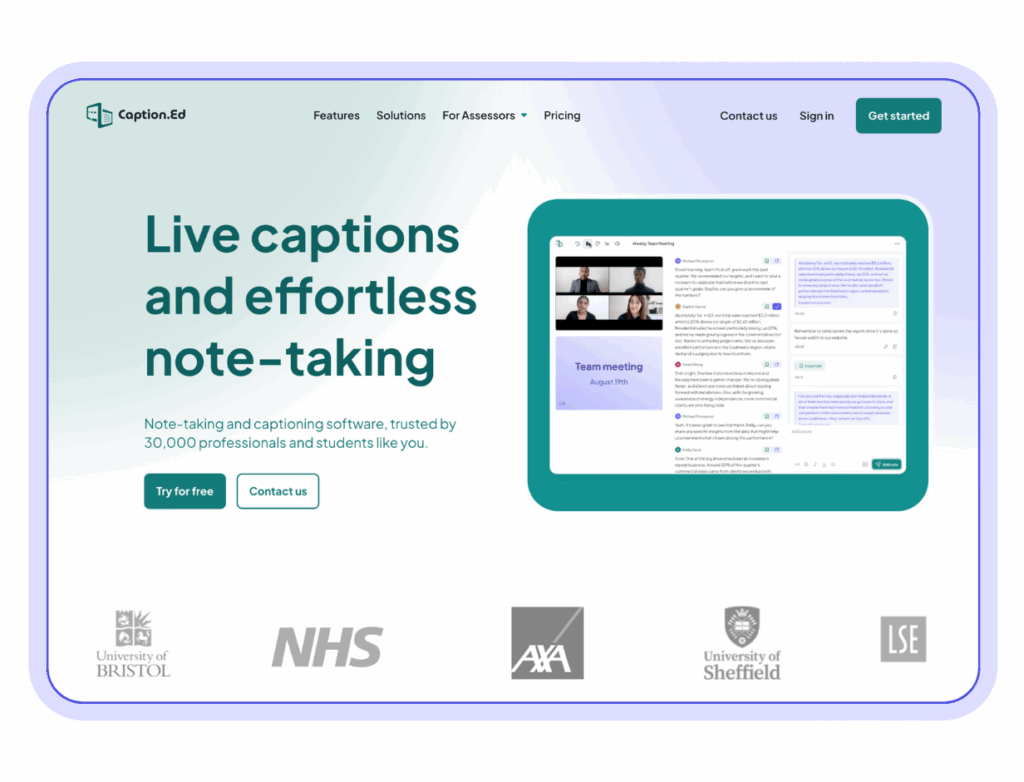
Caption.Ed is a transcription platform designed to work wherever you do: whether that’s a live lecture, an online meeting, or reviewing pre-recorded content. Unlike most tools that only focus on one area (like meetings or human transcription), Caption.Ed covers the full range: live captions, file-based transcription, and powerful AI summaries. It’s trusted across sectors such as education, healthcare, and finance because of its strong security credentials and accessibility-first design.
By combining real-time captions with AI-powered productivity features, Caption.Ed helps users not only capture what was said but also turn it into something actionable, from concise summaries to key action points. Add in ISO 27001 certification, SSO support, and cross-device compatibility, and it becomes clear why Caption.Ed is often positioned as the all-rounder.
Pros:
- Exceptional accuracy, both for live and pre-recorded content.
- Provides real-time captions for online and in-person meetings.
- Powerful AI features, including summaries and AI Actions for faster workflows.
- Enterprise-grade security with ISO 27001, SSO, and strong data protection.
- Works seamlessly across devices (Mac, Windows, Chromebook, and mobile) and major video conferencing tools (Zoom, Teams, and Google Meet and more).
- Built-in accessibility features designed with neurodivergent and disabled users in mind.
- Free for users eligible for Access to Work (AtW) or Disabled Student Allowance (DSA).
Cons:
- No permanent free plan for individual users outside of AtW and DSA.
Pricing:
- Free trial available.
- Individual Lite: £25/month or £300/year
- Individual Pro: £50/month or £600/year
- Enterprise: Pricing varies by number of licenses. Contact Caption.Ed to find the most cost-effective plan for your organisation.
Best for human-powered transcription
Rev
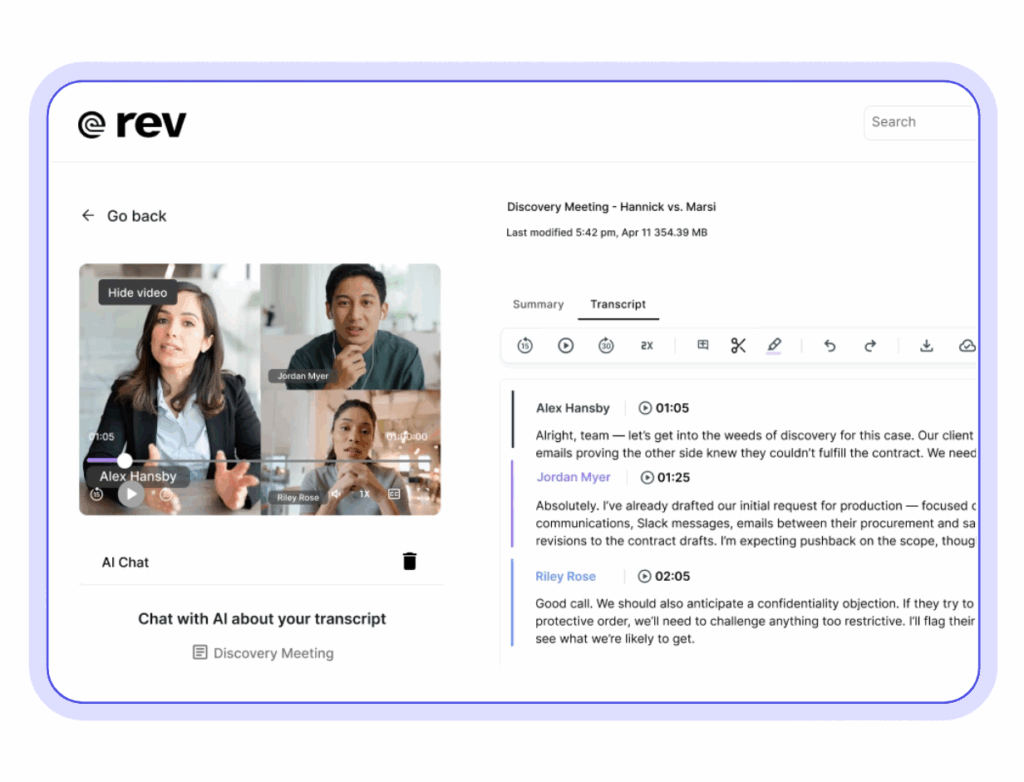
Rev balances AI transcription with highly accurate human-powered services, making it one of the most recognised names in transcription. It’s especially useful for journalists, researchers, and businesses who need near-perfect accuracy, with human transcriptionists delivering up to 99%. The platform also supports captioning and subtitling for videos and includes collaborative editing tools, though some users find the AI features less polished than competitors.
Pros:
- Human transcription accuracy up to 99%.
- Fast turnaround and collaborative editing features.
- Mobile app for recording and uploading on the go.
Cons:
- AI summaries can feel robotic.
- Speaker identification isn’t always reliable.
- Free plan is limited.
Pricing:
- AI Transcription: $0.25/minute or $14.99/user/month (20 hours).
- Human Transcription: $1.99/minute.
- Free 14-day trial available.
Platforms: Web, iOS, Android.
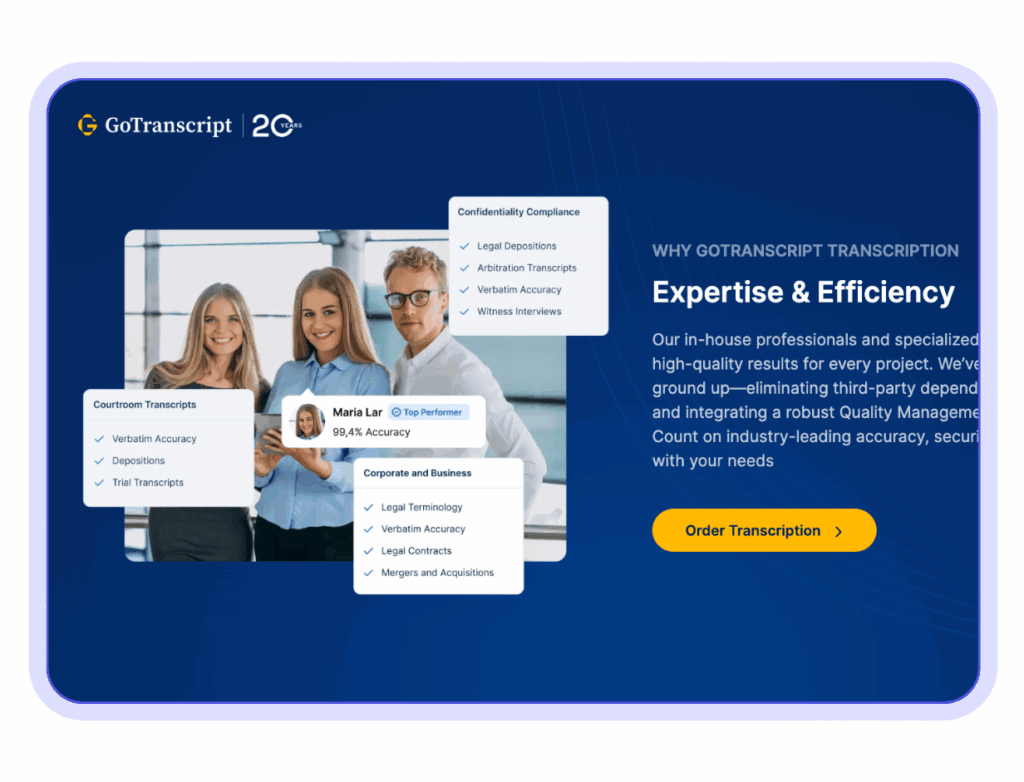
GoTranscript specialises in affordable human-powered transcription, offering accuracy of up to 99% across industries like legal, medical, and academic research. Its flexible turnaround options make it appealing for users working to deadlines, and with wide language support, it’s a solid choice for international projects. That said, its automated service doesn’t hold up against newer AI-first platforms.
Pros:
- High accuracy (up to 99%).
- Affordable compared to other human services.
- Industry-specific expertise.
- Wide language support.
Cons:
- Automated transcription is weaker.
- No dedicated mobile apps.
- Website can feel clunky.
Pricing: Based on file length and turnaround time.
Platforms: Web.

Scribie uses a hybrid model, combining an initial AI transcript with human editing to achieve high accuracy at lower costs than pure human services. It’s a practical option for users who want reliable transcripts without premium pricing, though the lack of mobile apps and limited advanced AI features may be a drawback for some.
Pros:
- Hybrid process balances cost and accuracy.
- Easy-to-use web interface.
- Faster turnaround than pure human transcription.
Cons:
- No mobile apps.
- Limited advanced AI features.
Pricing: Pay-as-you-go per minute.
Platforms: Web.
Best for AI meeting notes
Otter.ai
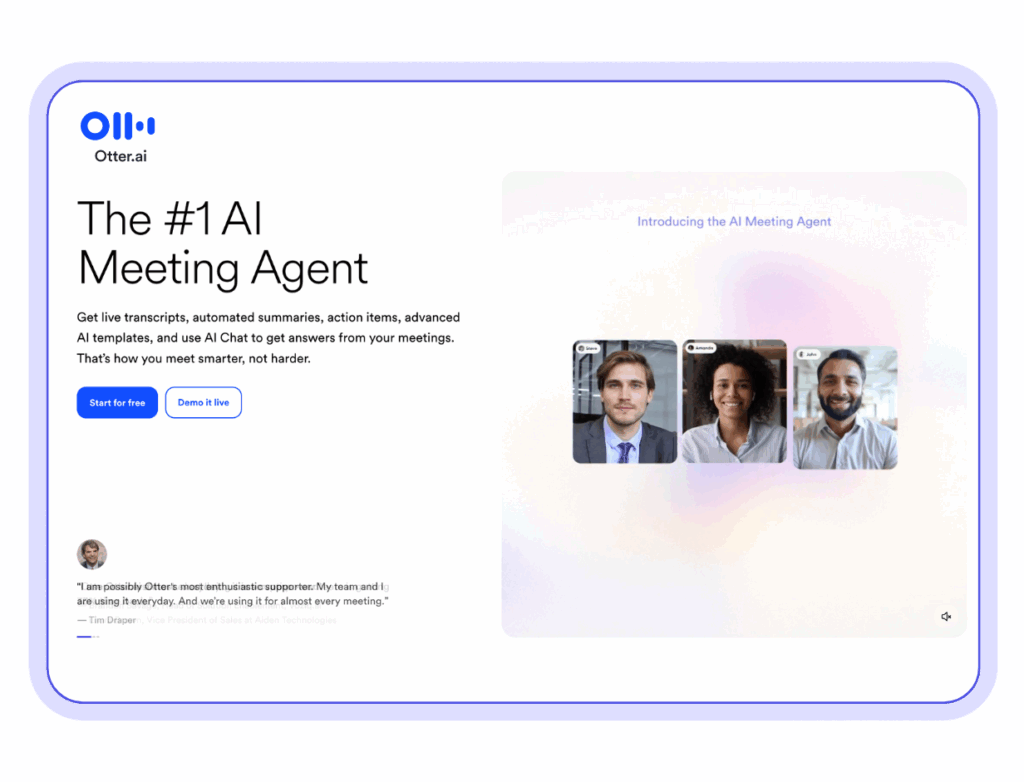
Otter.ai is widely used for transcribing live conversations in meetings and lectures. Its real-time transcription and generous free plan make it popular with both students and professionals, while its AI assistant helps summarise key points. However, accuracy can dip with accents or technical jargon, and the free plan limits pre-recorded uploads.
Pros:
- 300 minutes/month free live transcription.
- Real-time meeting transcription.
- AI assistant for summaries and insights.
- Works with Zoom, Teams, and Google Meet.
Cons:
- Accuracy struggles with accents.
- Pre-recorded uploads are limited on the free plan.
- Speaker identification can be hit-and-miss.
Pricing: Free plan available. Paid plans start at $8.33/user/month (billed annually).
Platforms: Web, iOS, Android.
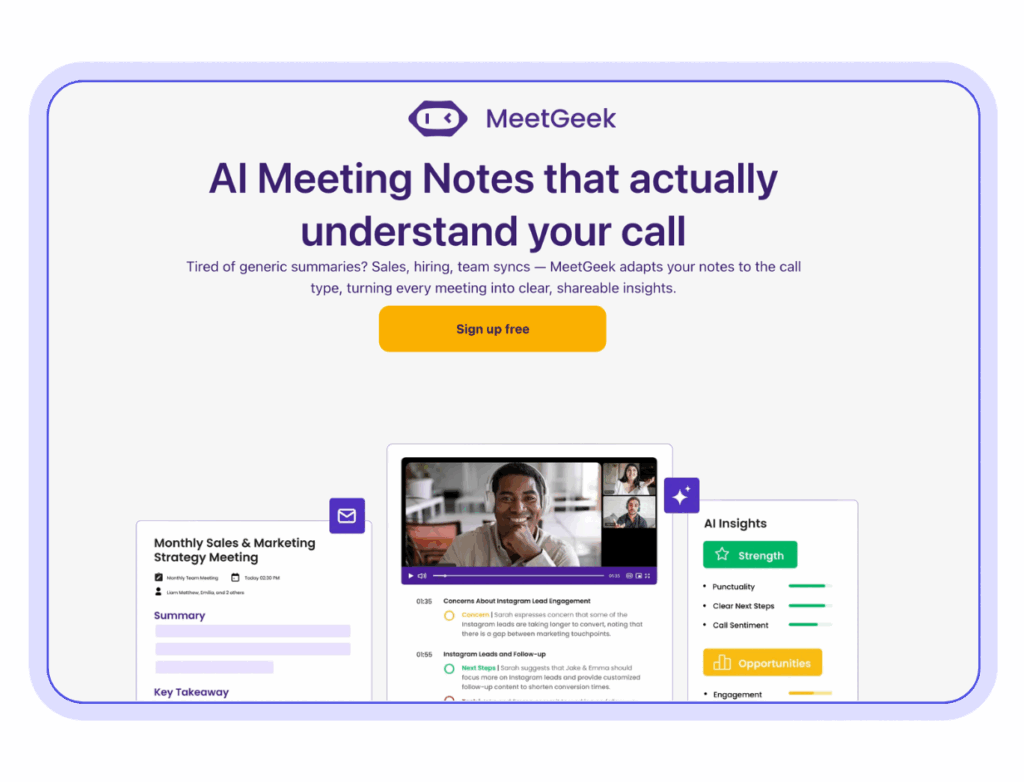
MeetGeek focuses on turning meetings into actionable notes. It automatically records and transcribes calls, then generates AI-powered summaries that can be customised to match your team’s needs. While it integrates smoothly with conferencing platforms, the free plan is restrictive, and transcripts can occasionally miss minor words.
Pros:
- AI summaries with customisable templates.
- Integrates with major video conferencing platforms.
- Automates meeting transcription.
Cons:
- Limited free plan.
- Can miss minor words.
Pricing: Free plan available. Paid plans unlock unlimited transcriptions.
Platforms: Web.

Fireflies.ai works as a meeting assistant that joins calls, transcribes them in real time, and produces AI summaries with action items. It integrates with popular tools like Slack, Zoom, and Notion, making it handy for busy teams. The trade-off is that its most useful features are locked behind paid plans, and speaker identification isn’t always consistent.
Pros:
- Automatic meeting recording and transcription.
- AI generates summaries and action items.
- Integrates with Zoom, Slack, Notion, and more.
Cons:
- Speaker identification inconsistencies.
- Best features require a paid plan.
Pricing: Free plan with limited features. Paid plans available.
Platforms: Web.
Best for language support
HappyScribe
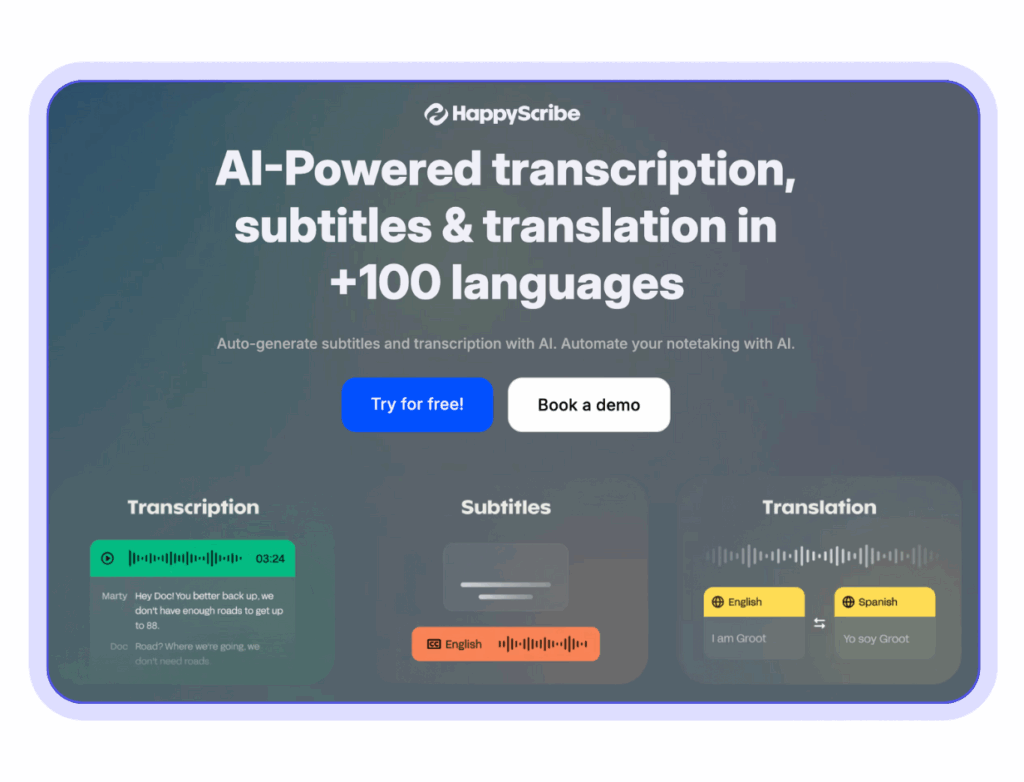
HappyScribe is best known for its extensive language support, covering over 120 languages and accents. It offers both AI and human transcription, making it versatile for international projects. However, while the platform is easy to use, its automated accuracy is only around 85%, and the human-powered option comes at a steep price.
Pros:
- Wide language support.
- Offers both AI and human transcription.
- User-friendly platform.
Cons:
- Human transcription is expensive ($120/hour).
- AI accuracy is lower (around 85%).
- Free trial is restrictive.
Pricing: Free plan available. Paid plans from $19/month.
Platforms: Web.
Specialist transcription tools
- InqScribe (Hands-free transcription): Desktop software that works with foot pedals for manual transcription.
- oTranscribe (Interview transcription): Free, browser-based, simple tool for manual interview transcription.
- VOMO AI (Research interviews): Fast and accurate for large batches, includes speaker ID and summaries.
- TranscribeMe (Confidential transcription): Emphasis on data security, offers automated and human services.
- Alice (Pay-as-you-go): Flexible pricing with minutes that never expire, privacy-focused.
- Descript (Podcasters & creators): Combines transcription with audio/video editing.
- Castmagic (Content repurposing): Creates social media assets from transcripts.
- Transcript LOL (Content repurposing): AI tool for repurposing transcripts into blogs, posts, and newsletters.
- Trint (Collaborative editing): Advanced editing and team collaboration features.
- Sonix (Web embedding): AI transcription with tools to embed transcripts and subtitles into websites.
Why are more people choosing Caption.Ed for transcription?
Compare Caption.Ed against a selection of other captioning and note-taking providers.
How can Caption.Ed help with specific use cases?
Learn more about some of the ways Caption.Ed can help users in education and at work.
Free or paid transcription software?
It’s tempting to stick with free transcription apps and for light, occasional use, they can do the job. Tools like Otter.ai or oTranscribe are great if you just need the odd transcript and don’t mind a few inaccuracies. The main drawback is that free tiers usually come with strict limits on recording length, monthly usage, or file uploads. Accuracy can also be inconsistent, especially with different accents or technical vocabulary, and accessibility features are often missing.
Paid tools, on the other hand, are designed for reliability. They tend to offer better accuracy, more robust AI features, and fewer restrictions. This matters if you’re relying on transcription every day, sharing notes across a team, or working in a professional or academic setting where precision is essential.
That’s where Caption.Ed sits. It combines the ease of live captions with powerful AI features and enterprise-level security — all in one platform. You get accurate transcription across devices, smart AI summaries, and accessibility built in from the ground up. If you want to see how it compares to free alternatives, you can try it out with a free trial of Caption.Ed.
Frequently Asked Questions
If you’re looking for a strong all-rounder, Caption.Ed stands out. It provides accurate live captions, file-based transcription, AI summaries, and enterprise-grade security, making it more versatile than tools that specialise in just one area.
Caption.Ed is one of the most accurate AI transcription tools available. Its real-time captions and file transcriptions are highly reliable, designed to minimise errors across a wide range of use cases.
Yes. Caption.Ed supports both audio and video transcription, whether you’re uploading a file or using live captioning during a call or lecture.
Caption.Ed’s AI helps you go beyond raw transcripts. It can summarise long conversations, extract key details, and turn transcripts into actionable outcomes like follow-up tasks or reports.
For organisations in sectors like finance, healthcare, or law, Caption.Ed offers enterprise-level security, cross-device compatibility, and accessibility features that free tools don’t provide.
Caption.Ed works seamlessly with major video conferencing platforms, providing live captions and transcripts that can be saved and shared with your team afterwards.
Caption.Ed makes every meeting and consultation accessible, secure, and efficient, helping healthcare organisations meet compliance standards, reduce administrative burden, and improve experiences for staff and patients alike.
Final verdict: The best transcription software for you
There are plenty of transcription tools out there, each with their own strengths. Some focus on human-powered accuracy, others on meeting summaries, and some on language support. But if you’re looking for a tool that can do it all, with real-time captions, accurate transcription, smart AI features, and built-in accessibility, Caption.Ed is the stronger overall choice.
It’s reliable enough for professionals, flexible enough for students, and secure enough for organisations handling sensitive information.
Ready to see the difference for yourself? Start your free trial of Caption.Ed today.
Ready to get started?
Join 30,000 people who are already transforming the way they work and study with Caption.Ed.
